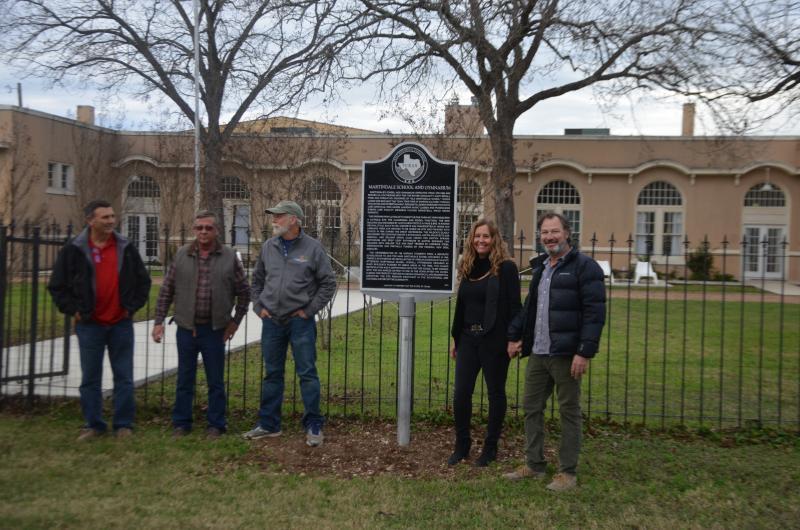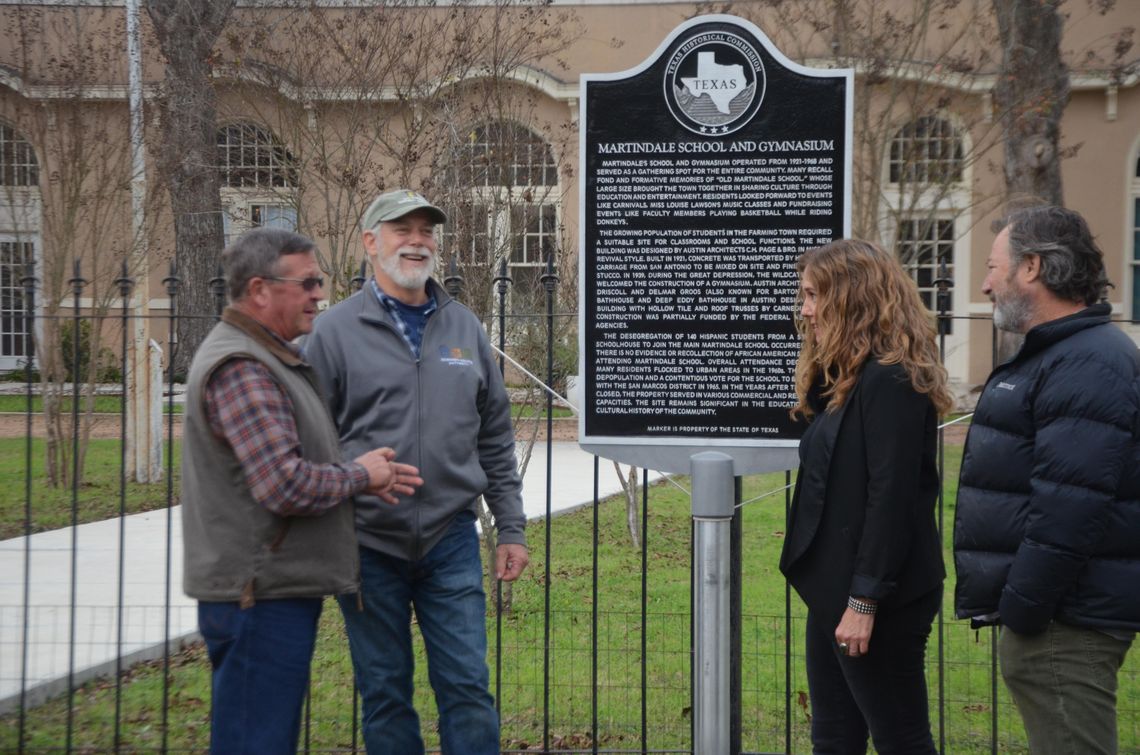MARTINDALE — A small crowd gathered around the old Martindale School and Gymnasium recently to celebrate its designation as an official Texas Historical Marker.
But the few alumni in attendance called it a special moment. For Mike Holmes, Jon Cradit and Danny Norris — who all attended the school in the 1960s before it closed and Martindale students began attending San Marcos Consolidated ISD — the landmark reveal ceremony marked an opportunity to reminisce.

Above, Mike Holmes, Jon Cradit and Danny Norris (left), all alumni of the old Martindale School and Gymnasium, stand next to a new historical marker, and Craig and Wendi Foster (right), who now own the property and have converted it to a wedding and lodging venue.
Holmes recalled the trio’s grade school days when they would spin around the playground’s merry-go-round as fast as they could. “We would get it going so fast, we’d see how far we could sling people off. I mean, today, it would be unheard of,” Holmes said.
Holmes also remembers roller skating on the school’s sidewalk.
“We used to bring our skates and they were those old metal skates,” Holmes said. “On the front of [the skates] they had two clamps you’d put on your shoe and then had an old metal key and you’d crank down tight on your shoe and just strap it on. We would skate up and down here like roller derby during recess.”
Norris recalls his father, Hillburn Norris, who served as a flag bearer in the U.S. Marine Corps during World War II, building the flagpole that still stands in front of the building. “It was pretty special for him to build that flagpole,” Norris said.
The schoolhouse located at 101 Lockhart St. in Martindale opened in 1921 and served as not only a school but also as the town’s central meeting place, according to Craig Foster, who owns the property now. The school, which closed in 1968, hosted school functions like plays, dances and sporting events as well as town meetings, fundraisers, carnivals and conventions.

Above, Craig Foster helps unveil a new historical marker issued by the Texas Historical Commission.
After its closing, the school was used in various commercial and residential capacities. In 2017, Craig and Wendi Foster bought the property and converted it into a lodging and wedding venue. The schoolhouse, which sits on 1.7 acres, is 5,900 square feet and includes multiple lodging rooms. The old gym — a 4,000 building built in 1939 which is now called Martindale Social Hall — is now used for weddings and events. The old school cafeteria is now used as a catering kitchen.
Craig Foster said he was drawn to the property after his kids graduated from high school and he and his wife wanted to explore work outside the corporate world.
“We drove by one day during the timeframe we were thinking about quitting our jobs and investing in a hotel or something. We saw the [for sale] sign in the yard and were like, ‘Huh’,” Craig Foster said. “We never thought about that as an option. Once we toured the place, we found out, ‘OK, we’ve got lodging, it’s got an events center, it’s got parking, it’s got infrastructure.’ We could do so many different things with it and that’s what excited us about it.”
Craig said within a few weeks they put their Austin home on the market, sold it and used the money to invest in Martindale Schoolhouse.
Craig said it was a no-brainer to seek a designation as a Texas Historical Marker. But the application process was daunting. He said he wrote a 10-12 page essay, which included a detailed history of the schoolhouse with footnotes, bibliographies and indexes. He did much research through discussions with alumni and by rummaging through the archives of the San Marcos Daily Record and Lockhart Post Register.
To qualify for a marker, two basic criteria must be met: historical significance and age. According to the Texas Historical Commission, historical significance is met by reviewing the subject's role and importance in local history, while the age requirement depends on the topic.
“The Official Texas Historical Marker program helps bring attention to community treasures and the importance of their preservation,” THC Executive Director Mark Wolfe said in a statement. “Awareness and education are among the best ways to guarantee the preservation of our state’s history. This designation is a tool that will increase public awareness of important cultural resources.”
Craig described his feelings as “satisfying” after unveiling the old Martindale School and Gymnasium marker during the ceremony that took place on Dec. 19.
“It validates kind of just the history of it,” Foster said. “It’s not so much anything I did. I mean, yes, it was a lot of hard work gathering, researching and writing. I felt like I was back in school again. But the building speaks for itself, the history speaks for itself. People are still living that [went to school here]. There are formative memories. It really was the only game in town in terms of place to go when you were growing up in Martindale.”
Inside the schoolhouse, a hallway features class photos and the history of the school. Holmes said a part of his family’s past remains at the school.
“One of the pictures in there is the class of [1938] — both my mom and my dad graduated high school here in the ‘38,” Holmes said. “Later on my dad [Everett Holmes] was the principal and superintendent here the whole time we went. So then I went, so I mean my whole heritage and family history is here at this school.”

Above, pictures line a hallway in the Martindale Schoolhouse, keeping the history of the building alive.
With the new historical designation, Cradit said he’s glad an interest still remains in the school even 53 years after it closed.
“I really appreciate them going through the trouble of doing all this,” Cradit said. “I really hated to see it as a mechanic shop and all that other stuff … and whenever the roof of the old gym caved in and the floor was rotted out, I just hated to see it deteriorate. It’s so cool to see someone take a love in it now and fix it back up.”
The inscription on the Martindale School and Gymnasium marker reads:
“Martindale School and Gymnasium operated from 1921-1968 and served as a gathering spot for the entire community, many recall fond and formative memories of 'Old Martindale School,' whose large size bright the town together in sharing culture through education and entertainment. Residents looked forward to events like carnivals, Miss Louise Lawson’s music classes and fundraising events like faculty members playing basketball while riding donkeys.
“The growing population of students in the farming town required a suitable site for classrooms and school functions. The new building was designed by Austin Architects C.H. Page & Bros. in mission revival style. Built in 1921, concrete was transported by horse and carriage from San Antonio to be mixed onsite and finished with stucco. In 1939, during the Great Depression, the Wildcats gladly welcomed the construction of a gymnasium. Austin Architects Dan Driscoll and Delmar Groos (also known for Barton Springs Bathhouse and Deep Eddy Bathhouse in Austin) designed the building with hollow tile and roof trusses by Carnegie steel. Construction was partially funded by the federal New Deal Agencies.
“The desegregation of 140 Hispanic students from a separate schoolhouse to join the main Martindale school occurred in 1948. There is no evidence or recollection of African American students attending Martindale School. Overall attendance declined as many residents flocked to urban areas in the 1960s. This caused depopulation and a contentious vote for the school to be merged with the San Marcos District in 1965. In the years after the school closed, the property served in various commercial and residential capacities. The site remains significant in the educational and cultural history of the community.”







